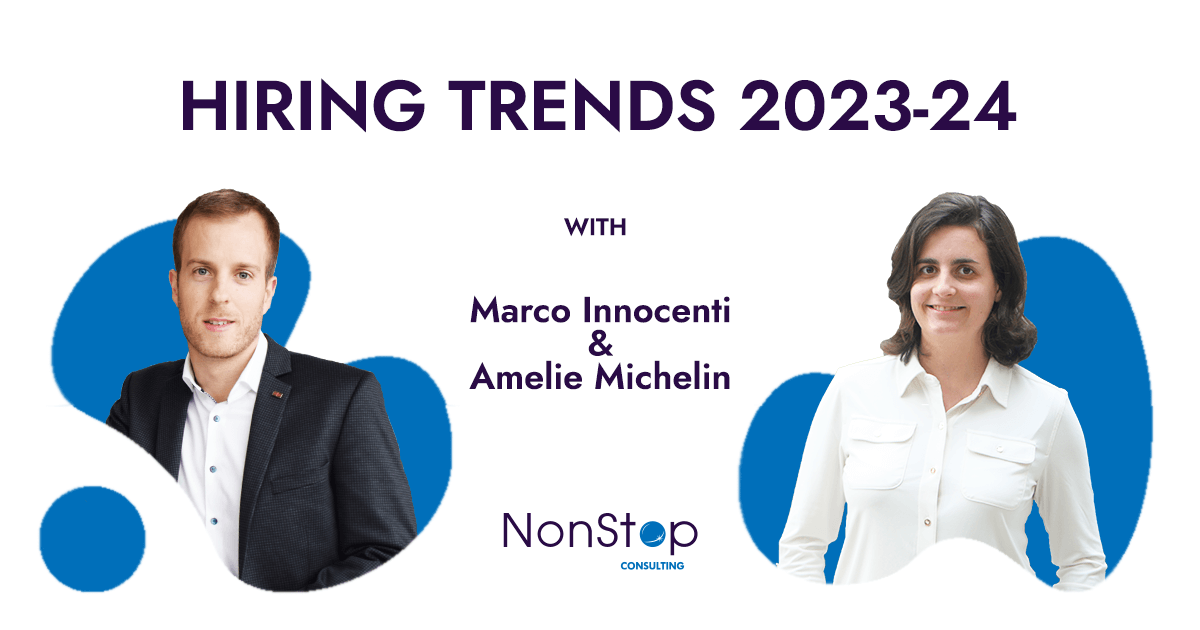Hiring trends across industries are constantly evolving as companies race to hire the best talent and candidate desires shape attraction strategies.
In recent years we’ve seen more widespread adoption of technology and creativity around benefits but as companies evolve to meet customer demand, so too do their hiring needs. Without staying on top of hiring trends amongst the talent pools they seek to attract, companies may struggle to find the people they need to keep moving the business forwards.
As professional recruiters constantly interacting with candidates and hiring managers across industries and countries, we have a front-row seat to the latest trends in the job market.
Based on what we’ve already seen this year and some year-on-year trends, we’ve developed this list of aspects we expect to shape hiring in the second half of this year and into next year.
Data science and artificial intelligence: The need for digital skills.
Companies of all sizes are increasingly investing in data science and artificial intelligence to drive efficiencies in both time and cost, and improve accuracy.
AI can help to automate tasks that are currently done manually, such as data entry, analysis, reporting, and customer service. This can free up employees to focus on more creative and strategic work. I can also automate manufacturing processes, leaving employees to take up roles with less health and safety risks.
AI can also identify patterns and make predictions that would be difficult or impossible for humans to do on their own, leading to process improvements and the discovery and development of new product lines.
This is leading to a demand for data scientists, AI engineers, and other tech-savvy professionals and demand is far outpacing supply.
According to the World Economic Forum’s Future of Work report, 85 million jobs will be replaced by AI by 2025, yet 97 million new jobs will be created.
The skills needed for these roles are not only in high demand, but the landscape is constantly changing, meaning people working in this space need to be constantly learning to keep up with new developments.
In addition to data scientists and AI engineers, people capable of leading the digital transformation journey as companies adopt this new tech and tools will be increasingly crucial, as will people in AI maintenance roles.
For more on how AI is impacting recruitment, see our previous article here.
A focus on diversity and inclusion.
While this isn’t necessarily a new trend, it’s something we are seeing as becoming more important for companies and therefore more engrained in recruitment processes.
It’s been widely documented that diverse teams have a positive impact on a business by bringing a wider range of perspectives, leading to improved decision-making, increased innovation, and an enhanced employer reputation.
As more states and countries move to enshrine diverse hiring in law, companies are redesigning hiring processes and talent attraction methods. This includes meticulous tracking of diversity criteria at each stage of the recruitment process.
It also includes more outreach activities with a wider range of educational and community organisations as companies seek to broaden their talent pools and attract those diverse candidates.
In turn, these efforts are having a positive impact on companies’ employer and commercial brands. Companies seen as being diverse and inclusive are more likely to attract top talent regardless of background or personal situation and win more customers too.
Particularly for companies operating in candidate-short markets, attracting job seekers from the widest range of people possible is the best way to fill those roles. However, it’s important to make sure hiring policies aren’t so strict that they alienate or exclude great candidates just because they don’t fall into a diverse or minority category. Not only will this see companies lose out on candidates, but it could have a detrimental effect on the employer brand.
One way to help ensure equal opportunity for all candidates is to provide unconscious bias training for everyone involved in the hiring process.
An increasing desire for cross-functional and soft skills.
As companies compete for customers and race to stay ahead of technological advancements, those businesses become increasingly complex and subject to change. Therefore, employees with cross-functional and soft skills are increasingly becoming highly valued.
Employees able to work across functions contribute an increased understanding of the wider business needs and therefore an ability to help drive better decision-making and help companies realise business priorities efficiently.
Soft skills such as good communication, problem-solving, leadership, and teamwork skills, for example, are increasingly seen as more important than technical skills in the workplace as they can help employees build relationships, solve problems, and work effectively in teams.
The combination of these skills can lead to more productive employees as they are better able to communicate with others, collaborate on projects, and resolve conflicts. It can also contribute to a positive workplace culture and therefore increased retention rates.
For those in customer-facing roles, having these skills can help increase customer satisfaction too, leading to increased profitability.
A growing desire for continuous learning.
Jobseekers seem to be increasingly looking for roles that provide learning and development opportunities as they seek to build long-term careers.
Given the pace of change in almost every industry, skills learned in university, for example, can quickly become outdated and employees recognise the need to keep up-to-date with their training.
On top of helping employers grow the skills they need, providing internal training or budgets for external training is therefore a great talent attraction and retention method.
It can also improve employee performance, which not only leads to increased productivity, efficiency, and innovation, but also job satisfaction and therefore engagement rates.
Shifting demands around remote work.
The pandemic accelerated the shift to remote work, and we’ve seen this as a key benefit of interest to job seekers ever since.
There are some key reasons why remote working is desirable, including the flexibility and work-life balance it can offer, and cost savings due to not having to commute.
On the employer’s side, there are cost savings too without the need to invest in office space, utilities, and other overheads.
However, we’ve also noticed an increasing demand for the opposite more recently. Many employees now stuck in permanently home-based roles are looking to get back to office-based roles, or hybrid roles.
It’s therefore crucial that employers take this into consideration and conduct market research to understand what their target talent pools are searching for.
For example, many tech workers such as IT developers still prefer remote roles while those in roles that might require more instant communication, such as project management, HR, sales, and so on, tend to prefer office-based or hybrid roles.
One of the key reasons we’ve found people are looking to move away from remote working is a feeling of isolation and disconnection from the team.
Other common reasons include technical issues with slow or unreliable internet connections and, in some cases, a worse work-life balance as they tend to work later than they would in an office, skip breaks, or find it difficult to disconnect.
A growing recognition of the importance of employee engagement.
Employee engagement is important for attracting and retaining talent because it helps to create a positive work environment where employees feel valued and motivated.
When employees are engaged, they are more likely to recommend the company to their own networks and are less likely to leave their jobs. They are also more likely to give a positive impression to anyone they interact with in an interview process.
So while it’s not exactly a hiring trend, we are seeing companies that are struggling to attract great talent start to consider this wider picture.
How do we stay on top of trends?
We talk with hundreds of candidates on a daily basis so gain a unique picture of what salary ranges they are expecting, what kind of benefits and work environment they would like, and what would tempt them away from their current roles.
We also talk to many hiring managers each day so get a good sense of what companies are looking for in a candidate, including the skills and experience desired for certain roles, the salary ranges they are willing to pay, what benefits they offer, and what more they might be able to offer for the right candidate.
In addition, we are constantly tracking and analysing data on job postings, salaries, hiring patterns, and more to help us stay ahead of the curve and spot emerging trends.
Finally, let’s look in more detail at why it’s important for companies to stay on top of hiring trends.
To attract top talent
Top talent is always going to be in demand and the best candidates will always be looking for the best opportunities, which includes easy hiring processes, as well as the job and benefits on offer. By staying informed, companies can make sure their hiring processes are competitive and that they’re offering attractive benefits and compensation packages.
To retain top talent
Once a company has attracted great employees, it’s important to retain them. Staying informed of hiring trends can also help companies retain talent by understanding what these employees are looking for in the workplace. For example, if a trend shows that employees are looking for more flexible work arrangements, a company can adjust its policies to offer these arrangements in order to retain top talent.
To improve hiring processes
Understanding hiring trends can also help companies to improve their hiring process. For example, we have seen companies lose out on great candidates in their interview process because that process was too long and complicated and the candidate received another offer in the meantime.
To save money
Finally, which company doesn’t want to save money where it can? Staying informed of hiring trends can also help companies to save money by eliminating underperforming attraction channels. For example, for the last several years at least employment rates have been relatively high and many industries have faced candidate shortages meaning the best candidates are most likely not looking or applying for jobs on job boards. This has meant alternative candidate generation methods were needed, such as headhunting.





